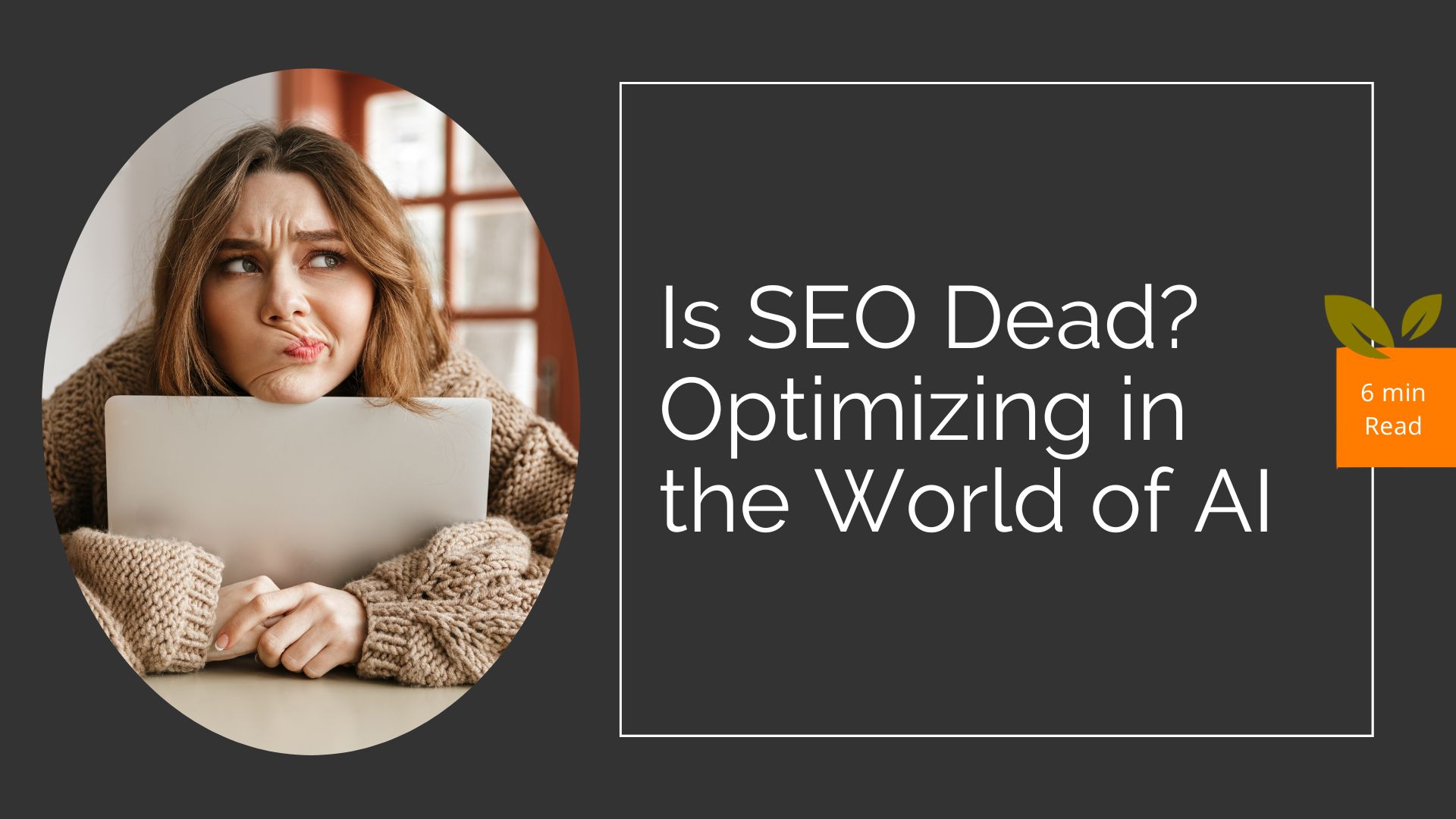Get Found and Grow: SEO Optimized Blogging

So you’re blogging… that’s a great start. You’ve mastered your voice, you’re providing value to your audience and you’ve achieved a regular cadence. But if you aren’t optimizing all that great content for SEO, you are shooting your blog strategy in the foot. It will never be able to run the marathon your business needs to get found. It’s time to learn the basics of SEO-optimized blogging.
Is SEO Dead? A Brief History
But wait, SEO is dead, right? That’s what all the headlines keep saying. Don’t be fooled by headlines designed to disrupt the conversation and get your attention — after all, those businesses are also doing their best to reach their audience (you). At its broadest definition, SEO (or search engine optimization) involves any steps taken to improve content’s ability to rank for a specific keyword.
When SEO was born more than 20 years ago, those optimizations often took the form of trying to trick the search algorithm into favoring your content. The search engines got smarter over time, and so did the SEO strategists. Tactics fell into “white hat” and “black hat” categories, the latter of which could get your site banned from search. White hat tactics evolved from a set of triggers that would dramatically increase your page’s chance to a baseline set of “must haves” you needed to even get in the game. Today, with AI replacing algorithms, it’s never been more difficult to get ranked. But there are still steps you need to take to increase your chances. Those steps are collectively referred to as SEO.
People touting that “SEO is dead” are referring to that finite set of older tactics that are no longer the magic bullet they used to be. But, in our experience with digital marketing, we know that SEO-optimized blogging still needs to be a critical part of your overall strategy.
Original, High-Value Content Is Key
The single most important thing you can do for SEO is to create original content that is of high value to your target audience. That means NOT using ChatGPT to create another “10 Things Your Business Needs to Thrive” article. You need to know your audience. What are their pain points or concerns? What is keeping them up at night? What questions do they need to have answered? Then write content that addresses those concerns. Make it personal and engaging.
Make your audience the hero. Doing so is a key principle of StoryBrand websites but can also be applied to content writing. Don’t talk about your business services and how you solve problems. Empower your audience to understand and solve their own problems.
Optimize Your Content for Search Engines
The best content in the world won’t be indexed if it doesn’t meet some basic criteria. These are easy SEO triggers to pull to give your post the best chance (pulling these triggers alone will not get you ranked — you still need engaging high-value content). Here’s a simple checklist:
- In every blog post, be sure your target keyword appears in the:
- H1
- H2 (at least one)
- First paragraph (not linked to another page)
- Meta title
- Meta description
- URL
- Image ALT tag for at least one image on the page
- Image filename for at least one image on the page
- Include a link to the most relevant pillar page on your site for that topic in the first paragraph. The text that links out cannot contain any part of the target keyword. The easiest way to find the pillar pages is to look at the website header: sections called services, solutions, industries and so on can all contain pillar pages.
- Don’t overuse the main keyword. It should appear four of five times tops in a post of average length. Use alternate keywords as well.
- If you are using a stat or quoting an outside source, include the source and a link in the body copy. Citations add to credibility.
- Check for typos, weird spacing, unusual characters or anything else that might signal to a search engine (or user) that you are not a trustworthy source.
Make Sure Your Content Gets Traffic
Here’s the Catch-22 of ranking for search — if your site has little to no traffic, it is not likely to rank. And it’s hard to get traffic without organic search. One way to drive traffic is with your existing customer base. Create a newsletter and send out links to content on your site that customers will value. Driving newsletter readers to your site should create highly engaged baseline traffic to build from.
Social media is not the traffic driver it used to be, so, while it is important to include social content in your strategy, it won’t have much impact on SEO. (Still, there is some credibility to be gained by having regularly updated social channels that link to your site.)
Apart from blogging, we advise our clients that the best way to build site traffic is often with a paid search campaign. While this isn’t organic traffic, it is traffic. Make sure it is highly relevant traffic to give your site the best engagement and overall boost.
SEO-Optimized Blogging for Business Growth
If you are a business in growth mode, an SEO plan is a must-have. To be most effective, that plan needs to be strategic, consistent and expertly executed. Any content on your site can be SEO optimized, but not all should be. Optimizing pages like “about us,” “careers,” “locations” and other utility pages should take a backseat to the content that your audience is actually searching for. After all, if all your potential customers are already searching the internet to learn more about your brand, you probably don’t need to invest much in SEO. Start with your core service lines (pillar pages) and expand out from there. It’s not an overnight fix. These tactics can take six months or more to bear fruit. But the chances of getting anywhere without them are nonexistent.
Need help? Book a free strategy call to discuss your needs.
Share the knowledge
Get Killer Social Media Content Ideas at Our Webinar
Ah, social media. It sucks us in, gives us a community and can bring your business more sales if you use it correctly. If not,…
Explore this TopicHow Our Manufacturing Client Used Organic Search to Drive Leads and Scored a $150k Deal
Yes, you read that right, our marketing strategy brought one of our manufacturing clients a $150k deal. What is even better is that this marketing…
Explore this TopicCompTIA’s ChannelCon Insights
Have you ever heard the saying “your vibe attracts your tribe”? Well, that saying rang true at CompTIA ChannelCon 2024. We learned much, but also…
Explore this TopicWhat Are MSP Websites?
MSP websites are websites dedicated to promoting managed service providers (MSPs), companies that offer a range of IT services. These websites typically provide information about…
Explore this TopicUnleash Your Inner Spielberg: StoryBrand Framework Secrets to Turn Your Website Into a Blockbuster!
Storytelling has been captivating audiences since humans first learned how to communicate. Stories hook us in and transport us to different worlds where we meet…
Explore this TopicWhat Is Digital Marketing for MSPs?
Digital marketing for MSPs includes tactics like content marketing, social media campaigns, email marketing and advertising. Effective digital marketing for an MSP usually demonstrates industry…
Explore this TopicWhat Is MSP Marketing?
Managed service providers (MSPs) play a pivotal role in the IT industry offering a range of services that help businesses manage their technology. That being…
Explore this TopicWhat Is Included in an MSP Marketing Plan?
A well-structured and creative marketing plan is crucial for managed service providers (MSPs) to stay on top of the competition in the ever-evolving industry of…
Explore this Topic









